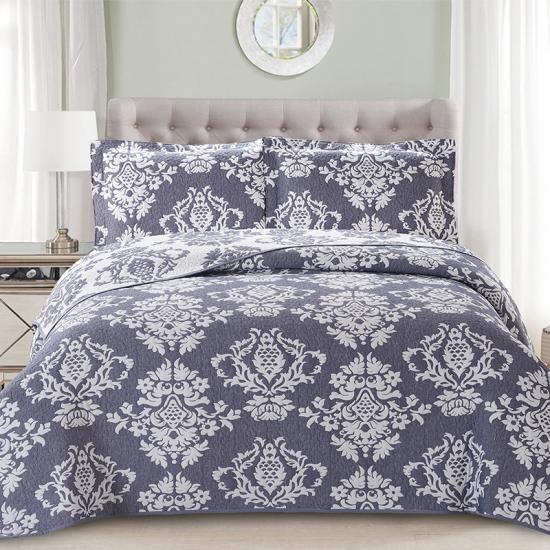The breathability of polyester microfiber Jacquard quilts compared to natural fibers like cotton or linen is a key consideration when evaluating comfort, temperature regulation, and moisture management. While each material has its own properties, there are notable differences in how they manage airflow, moisture, and heat.
Breathability of Polyester Microfiber Jacquard Quilts
Polyester microfiber is a synthetic material made from finely spun fibers that are designed to be lightweight, smooth, and soft. However, the breathability of polyester microfiber quilts tends to be lower compared to natural fibers. Here’s why:
Low Airflow: Polyester fibers, being tightly woven and chemically engineered, don't allow as much airflow as natural fibers like cotton and linen. This can make polyester microfiber less effective at allowing air to circulate through the fabric, potentially leading to a warmer or less breathable environment during sleep.
Moisture Retention: Polyester fibers are hydrophobic, meaning they repel water rather than absorb it. While this can be an advantage in terms of stain resistance and drying speed, it can also mean that the fabric retains moisture on the skin rather than wicking it away. This can make polyester microfiber quilts feel less breathable in terms of moisture management.
Temperature Regulation: Polyester microfiber does not regulate temperature as well as natural fibers. In warm conditions, it may trap heat against the body, making it less suitable for hot sleepers or in humid environments. On the other hand, in colder conditions, it can provide warmth but may not be as effective at ventilating excess heat.

Breathability of Natural Fibers (Cotton and Linen)
Cotton and linen are natural fibers that are generally known for their superior breathability, moisture-wicking properties, and ability to regulate temperature.
Cotton:
High Absorbency: Cotton fibers are highly absorbent, drawing moisture away from the skin and allowing it to evaporate more effectively. This makes cotton quilts breathable because the fabric does not trap moisture or heat against the body. Cotton helps maintain a cooler and more comfortable sleeping environment, particularly in warm climates.
Good Airflow: Cotton allows more air circulation than synthetic fibers like polyester. This helps prevent overheating and ensures that the fabric can breathe, keeping the user from feeling too hot or clammy.
Temperature Regulation: Cotton has natural insulating properties, but it remains breathable enough to keep the body at a comfortable temperature. In cooler weather, it traps air in the fibers to keep warmth in, while in warmer weather, it allows heat to escape, helping regulate body temperature.
Linen:
Superior Breathability: Linen, made from the flax plant, is one of the most breathable natural fabrics. Its fibers are more porous and have an open weave, which facilitates air circulation and helps regulate body temperature better than polyester microfiber.
Moisture Wicking: Like cotton, linen is excellent at absorbing moisture and releasing it into the air, making it a great choice for people who sweat more at night or live in humid climates. It allows moisture to evaporate quickly, preventing the buildup of sweat and helping to keep the sleeper cool and dry.
Cooler in Hot Weather: Linen is known for its cooling properties, and it is often favored in warm climates because it keeps the body cooler by allowing excess heat to escape. It also dries quickly, which is an advantage in terms of comfort during the night.
Conclusion: Which is Better for Breathability?
Cotton and Linen are far superior to polyester microfiber when it comes to breathability and moisture management. These natural fibers allow air to circulate more freely, keeping the sleeper cooler and drier. This makes cotton and linen quilts better suited for warmer climates or for people who tend to sleep hot.
Polyester microfiber, while soft, lightweight, and durable, tends to trap heat and moisture, which can lead to discomfort during warm nights or in humid conditions. Its breathability is limited, and its moisture-wicking properties are not as effective as those of cotton or linen.















.jpg?imageView2/2/format/jp2)
.jpg?imageView2/2/format/jp2)
.jpg?imageView2/2/format/jp2)
.jpg?imageView2/2/format/jp2)
.jpg?imageView2/2/format/jp2)
.jpg?imageView2/2/format/jp2)
.jpg?imageView2/2/format/jp2)

.jpg?imageView2/2/format/jp2)